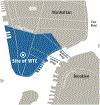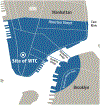The World Trade Center Health Program: an introduction to best practices
- PMID: 36533439
- PMCID: PMC10277307
- DOI: 10.1080/19338244.2022.2156975
The World Trade Center Health Program: an introduction to best practices
Abstract
More than 20 years have elapsed since the September 11, 2001 (9/11) terrorist attacks on the World Trade Center (WTC), Pentagon and at Shanksville, PA. Many persons continue to suffer a variety of physical and mental health conditions following their exposures to a mixture of incompletely characterized toxicants and psychological stressors at the terrorist attack sites. Primary care and specialized clinicians should ask patients who may have been present at any of the 9/11 sites about their 9/11 exposures, especially patients with cancer, respiratory symptoms, chronic rhinosinusitis, gastroesophageal reflux disease, psychiatric symptoms, and substance use disorders. Clinicians, especially those in the NY metropolitan area, should know how to evaluate, diagnose, and treat patients with conditions that could be associated with exposure to the 9/11 attacks and its aftermath. As such, this issue of Archives contains a series of updates to clinical best practices relevant to medical conditions whose treatment is covered by the WTC Health Program. This first paper in the 14-part series describes the purpose of this series, defines the WTC Health Program and its beneficiaries, and explains how relevant Clinical Practice Guidelines were identified. This paper also reminds readers that because physical and mental health conditions are often intertwined, a coordinated approach to care usually works best and referral to health centers affiliated with the WTC Health Program may be necessary, since all such Centers offer multidisciplinary care.
Keywords: 9/11; September 11; World Trade Center; adults; chemical exposure; chemical mixtures; clinical practice guideline; exposure; occupational diseases; quality; respiratory diseases; workers.
Figures


References
Publication types
MeSH terms
Grants and funding
LinkOut - more resources
Full Text Sources
Medical
Research Materials
